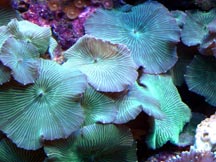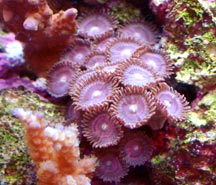
All of the previous situations can cause an imbalance in the nitrogen cycle, and make it necessary for us to monitor the level of toxins in the system whenever they occur. If any level of either ammonia or nitrites is detected, it is important to control these toxins either through partial water changes, or with one of the available toxin-absorbing resins.
 When performing water changes, it is important to change no more than 25% of the aquarium water at a time. Changing more than 25% of the aquarium water can cause rapid changes in both temperature and pH, which can result in added stress to the aquarium inhabitants. Therefore, if toxins are present, it is best to perform small water changes frequently (even daily) rather than performing large water changes at less frequent intervals. Again, the makeup water that is used to replace the aquarium water should be treated by reverse osmosis, distillation, or at the very least using a liquid dechlorinator. It is ideal that the makeup water is at the same temperature as the aquarium, and has been aerated prior to adding it to the aquarium.
When performing water changes, it is important to change no more than 25% of the aquarium water at a time. Changing more than 25% of the aquarium water can cause rapid changes in both temperature and pH, which can result in added stress to the aquarium inhabitants. Therefore, if toxins are present, it is best to perform small water changes frequently (even daily) rather than performing large water changes at less frequent intervals. Again, the makeup water that is used to replace the aquarium water should be treated by reverse osmosis, distillation, or at the very least using a liquid dechlorinator. It is ideal that the makeup water is at the same temperature as the aquarium, and has been aerated prior to adding it to the aquarium.
There are many chemical medias available on the market that will help control sudden increases in ammonia. By stopping the ammonia prior to it being broken down by the bacteria, we are reducing the biological load on the system. These products can be useful in the situations that have been described above. Again, it is important when using these products to monitor the water quality, and to perform water changes when any toxin levels are detected.
 Know the warning signs
Know the warning signs
It is not practical to constantly test and monitor your water for ammonia and nitrites, but there are signs that you can see within the aquarium. A sudden surge in ammonia levels can trigger a bacterial bloom often resulting in cloudy, aquarium water. Other signs include changes in behavior and appearance of the fish and invertebrates. When ammonia or nitrites are present in the water, the fish will show signs of stress. These signs can be in the form of erratic swimming behavior, gasping, or even laying on the substrate. These activities can also be the sign of disease, but our first reaction should be to test the water for ammonia and nitrites. Likewise, invertebrates such as corals will also show signs of distress. These signs are represented by the poor expansion of the coral, losses in coloration, and deterioration. If these signs do show themselves within the aquarium, it is then important to test the water for any amounts of ammonia or nitrites. If any levels are detected, then you must correct the situation by the methods described above.
Conclusion
This cycle takes time to stabilize the water conditions both in the initial set-up, and after adding livestock. It is important to stock your new aquarium slowly and to allow the cycle to be completed prior to adding any new inhabitants. If you understand this process, pay attention to the warning signs, and take appropriate actions, there is no reason for catastrophic die offs in the aquarium due to ammonia or nitrites.
[
Part 1 |
Part 2 |
Part 3 | Part 4 ] |